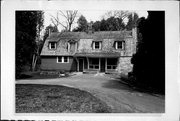Property Record
9409 COTTAGE ROW
Architecture and History Inventory
| Historic Name: | The Junipers |
|---|---|
| Other Name: | |
| Contributing: | Yes |
| Reference Number: | 48349 |
| Location (Address): | 9409 COTTAGE ROW |
|---|---|
| County: | Door |
| City: | |
| Township/Village: | Gibraltar |
| Unincorporated Community: | Fish Creek |
| Town: | 31 |
| Range: | 27 |
| Direction: | E |
| Section: | 29 |
| Quarter Section: | |
| Quarter/Quarter Section: |
| Year Built: | 1895 |
|---|---|
| Additions: | |
| Survey Date: | 1992 |
| Historic Use: | barn |
| Architectural Style: | Side Gabled |
| Structural System: | Balloon Frame |
| Wall Material: | Clapboard |
| Architect: | |
| Other Buildings On Site: | |
| Demolished?: | No |
| Demolished Date: |
| National/State Register Listing Name: | Not listed |
|---|---|
| National Register Listing Date: | |
| State Register Listing Date: |
| Additional Information: | #650: House 35-1. Historical Background The Clark family was the first to develop property along Cottage Row for a summer residence. George Clark, president of the Clark Jewel Company (stove manufacturers) was looking for a place to spend the summers away from Chicago. One of his salesmen knew of and suggested Door County. In 1896, Clark took the train to Menominee and boarded a boat for Ephraim. All of Ephraim was owned by Moravians who would not sell land to a non-Moravian. Clark went down to Fish Creek where Asa Thorp was very willing to sell of some of his land. Clark purchased the two mile strip of shoreline below the Fish Creek bluff. Retaining two sites on the north and south ends of the strip, he eventually sold the remaining lots to other patrons of the Thorp Hotel. In 1897 Clark built a house on the north end of his property closest to town (DR 35/1) [A says 1895, family says 1897]. The Clarks named the property "The Junipers." George Clark died circa 1927. His wife Elizabeth and daughter Alice stayed on in the house. They sold the property to William Ryan in the mid-1930s. The Ryans sold the property to Curly Lambeau in the 1950s. The main house burned in the 1960s, after which Lambeau renovated this carriage house and lived in it. Lambeau sold to the Steins, who built two small buildings on the site of the original house. These were moved off the site by current owner Don Schneider who constructed the present main house in the 1970s. George's son Robert built a house on the south end of Cottagw circa 1927 [36-12]. Historical Significance As with the other summer residences on Cottage Row, this property represents the pattern of living of wealthy urban midwesterners seeking to escape the heat of the cities. Mothers and children would spend the entire summer in Fish Creek, while the fathers would visit as their business schedules would allow. In some cases, several generations and family branches would share the same house. Architectural Description This house was originally the barn of the George Clark property. It is a side gable building sided in clapboard resting on a stone foundation. Windows have been replaced throughout the building, and four shed roof dormers added on the second story. The original massing and enough original building fabric remain to adequately reflect the original use as a barn. Architectural Significance The home was only intended for summer use. |
|---|---|
| Bibliographic References: | A. Archibald Douglass Cottage Row Building List. B. Betsy Guenzel, Fish Creek, The Summertime, privately printed, 1991. C. Betsy Guenzel, September 2, 1992 interview with Rebecca Sample Bernstein, White Gull Inn, Fish Creek. |
| Wisconsin Architecture and History Inventory, State Historic Preservation Office, Wisconsin Historical Society, Madison, Wisconsin |

